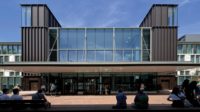Almere's 2022 Floriade Could Have Lasting Effects on the 40-Year-Old Dutch City

Architects & Firms
The Floriade is a Dutch-run exposition for horticulture and landscape design that occurs every 10 years. Previous iterations have been more like garden festivals designed to improve the existing parkland and green spaces of urban areas across the Netherlands. The first Floriade, for instance, was held in Rotterdam in 1960 and was used by city authorities to renovate public space and plant new formal gardens. The Euromast, an observation tower that still dominates Rotterdam’s skyline, was built then as a platform to view that enhanced landscape.
The 2022 Floriade—begun this past spring and ending in October—is spread out over 150 acres in Almere. It is still conceived as a place where exhibitors display innovations in horticulture. However, it is based on an urban grid, designed by the architects and planners MVRDV, to extend the center of Almere, a new town founded on reclaimed land.
“Unlike other Floriades, this one is embedded in the city structure,” says Klaas Hofman, senior associate for MVRDV, who worked closely with Almere officials to write the bid to host the event. “There’s a bus line already going to the site. The water opens up the opportunity for access by boat, and there’s the cable car.” Straddling four islands and, on the southern, landward side, a highway, the expo site is not obviously urban. To the northwest, a marina has been created and to the northeast, an island park.

Cable cars and a marina offer access to the site. Photo © Walter Herfst, click to enlarge.
Yet on the landward side, the urban grid features plots of up to a quarter-acre. The built area of each plot can only be 20 percent of the total; the rest must be landscape. During the Floriade, various pavilions from nations near and far provide exotic plantings around temporary structures. The UAE pavilion is a low wood building, for example, wrapped by a closed-loop bio-saline agriculture system: seawater and waste are recycled, using plants like mangroves and salt-tolerant succulents, to produce drinking water and irrigation to grow edible crops. Meanwhile, the High Tech Greenhouse shows off Dutch advancement in the science of plant nourishment: strawberries, gerberas, and peppers are grown within a sustainable feeding and irrigation loop.

Pavilions and built structures are minimal. Photo © Walter Herfst
In addition, the expo plan proposes parameters for city building. “We wanted a meaningful way to show the future of the city,” says Hofman, describing the extended grid as “a carpet of gardens.” Indeed, the physical effect that MVRDV’s plan produces is fascinating—an intensification of the Dutch agricultural landscape, where one finds greenhouses, often full of sophisticated hydroponic equipment, standing next to fields of tulips. The Floriade—with its highly planned intensive landscape on an urban-scale grid—blurs the distinctions between town and country, and technology and nature.
It is not yet clear whether the Almere authorities are embracing the potential the grid offers for a new urban paradigm. It would be a shame if the site—full of tulips, anemones, and narcissus clustered beneath apple and pear trees—were not built out as part of the city’s planned expansion. The government of the Netherlands wants a large number of the country’s new homes to be built in and around Almere, a city just over 40 years old, in the coming decade. The seventh Floriade expo is an important laboratory to test whether a future city district, with the capacity to produce food and energy, is viable.




